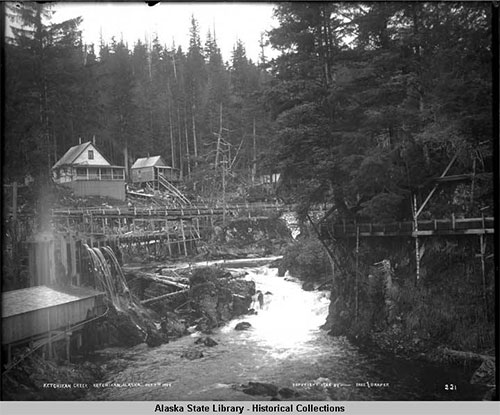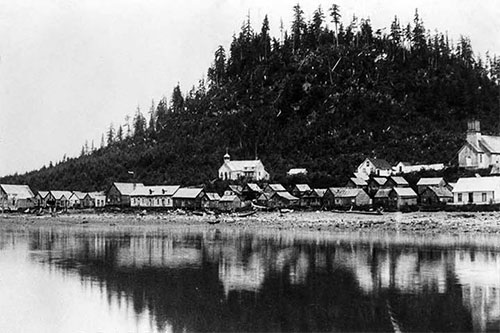Ketchikan Creek October 07,1905 |
The Klondike, though, was not the first gold strike to bring stampeders north seeking their fortune. There were other strikes, once again in Canada, in which the water routes through Alaska's Inside Passages were just as popular - and sometimes more so - than the overland routes through the rugged Canadian Rockies and the Coast Range.
Only a few decades after the Hudson's Bay fur trappers began piercing the interior of Western Canada in the early 1800s, reports of gold strikes began drawing fortune hunters into the area. The first smaller rushes were in the Queen Charlotte (now Haida Gwaii) Islands and the Cariboo Country in central BC in the 1850s.
In 1861, Alexander "Buck" Choquette staked a claim just downstream from the confluence of the Stikine and Anuk rivers. Choquette had married one of the daughters of Chief Shakes V, who presided over the Wrangell area at the mouth of the Stikine, which was then in Russian America but was being leased to the British and under their control. Choquette was a familiar presence in Fort Stikine and had also prospected throughout the area, particularly in Nass River area, not far from what was then Fort Simpson, now Lax Kw’alaams, a Hudson's Bay fort in northwest British Columbia.
When the claim, on Choquette's Bar, did produce some gold, there was a minor rush as several hundred mirs - different estimates say anywhere from 500 to 1,000 - went from Victoria to Stikine. Contemporary reports indicate that most ended up staying in Fort Stikine and never made it up the Stikine to the site of Choquette's Bar, some 150 miles from the mouth.
But interest in the area, led to the British government declaring sovereignty over the "Stickeen Territories" within a few years, setting the stage for a much larger gold rush in 1860, the Cassiar Rush.
In 1870, a prospector named Harry McDame found gold on what would later be called McDame Creek which was near Thibert Creek, which itself was a tributary of Dease Creek. This was to the north of Choquette's find in the Stikine area.
Fort Wrangell 1867-1896 |
In 1874 alone, more than $1 million in gold was brought of the McDame Creek area. That would be approximately $50 million in 2022. Approximately 10,000 gold seekers flooded the area, many passing through what was then called Fort Wrangel and up the Stikine. The Cassiar region - which soon included nearly all the upstream area on the Stikine and to the north - remained a magnet for gold seekers well into the early decades of the 20th Century.
In 1876, a miner named Alfred Christie discovered what would gain fame as the "Christie Lead" on a pair of small creeks parallel to McDame Creek. The lode of high concentrate gold was approximately ninety feet wide and a mile long and at the time generated a weekly return of approximately $5,000 for more than year before it ran out.
Part of the allure of the Cassiar Rush was the international publicity that occurred in 1876 when the largest gold nugget in British Columbia history was found in McDame Creek. A Prospector named Al Freeman found the 72-ounce gold nugget that was valued at $1,300 in 1877. That nugget would fetch more than $15,000 in 2022 prices.
In much the same way that the Stikine Rush had encouraged the British Government to move its authority northward in the 1860s, the Cassiar Rush caused a similar action in the 1870s. Gradually the Yukon Territory took shape, which led to the exploration that would lead to the Klondike Rush in the 1890s.
Since it was located at the mouth of the Stikine River, the newly acquired American town of Fort Wrangel benefited as a staging point for mining expeditions up the Stikine into the Cassiar gold fields. Wrangell - as it would later be called - would remain a significant "Alaskan" city until the Cassiar finds started decreasing in the mid 1890s. Around the time of the Klondike Gold Rush, several prominent Wrangell business owners moved to Ketchikan, where it was believed there were more mining opportunities moving forward into the 20th Century.
Another area of Southern Southeast that benefited by its proximity to Canadian gold and silver mines was the upper Portland Canal area near the Canadian border. As gold was found in Canada at the head of Portland Canal, the community of Portland City, later Hyder, sprouted up, reaching its zenith in the 1920s.
As for gold on the Alaska side of the international border in southern Southeast, there was little to be found on the American side for the next century. Certainly not in comparison to what has been found in the Juneau area in northern Southeast, where the Alaska-Juneau and Treadwell mines pumped out millions of dollars' worth of ore over the decades and the current Greens Creek - the largest operating silver mine in America - and the Kensington Mine continue to operate.
There are gold and silver prospects on Prince of Wales Island, but they have generally been overshadowed over the years by copper and uranium mines in the area over the years.
On the Web:
Columns by Dave Kiffer
Historical Feature Stories by Dave Kiffer
Dave Kiffer is a freelance
writer living in Ketchikan, Alaska. Dave Kiffer ©2022 Publication fee required. © |
Representations of fact and opinions in comments posted are solely those of the individual posters and do not represent the opinions of Sitnews.
Send a letter to the editor@sitnews.us
SitNews ©2022
Stories In The News
Ketchikan, Alaska
Articles & photographs that appear in SitNews are considered protected by copyright and may not be reprinted without written permission from and payment of any required fees to the proper freelance writers and subscription services.
E-mail your news & photos to editor@sitnews.us
Photographers choosing to submit photographs for publication to SitNews are in doing so granting their permission for publication and for archiving. SitNews does not sell photographs. All requests for purchasing a photograph will be emailed to the photographer.



